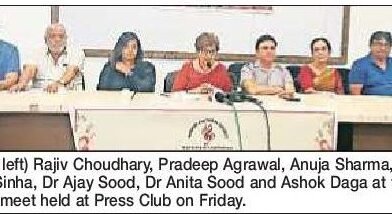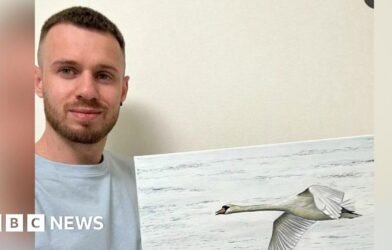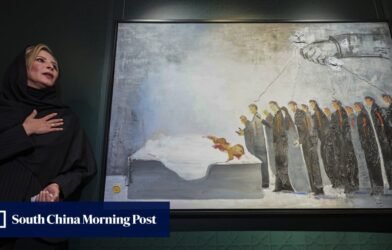After a storm hit the Ozark Mountains in the summer of 2023, artist Sarah Knight was left in awe of the aftermath. At their family farm on the Huzzah River in Missouri, they came across a fallen tree that had stood there since they were a kid. It was all ripped up, its roots exposed. And inside those roots they found a treasure of absorbed rocks.
That experience inspired Knight to create the first piece of the Queer Alchemy collection that year: “To Offer up a Grain of Sand.” The sculpture’s twisting arms are splattered with white, lime green, and sky blue. Knight incorporates Ozark druzy quartz, which protrudes from its limbs. Surrounding the ceramic artwork is a dusting of silica sand and Huzzah River gravel.
“I was very interested in that passage of time being revealed, especially in that really violent way, and that interaction between ecology and geology,” Knight says. “And that inspired that first piece, and pretty much all the subsequent other pieces after that.”
Queer Alchemy: Works By Sarah Knight is on display at the Northern Clay Center’s Galusha Gallery until November 3. The transgender artist’s collection explores the root of alchemy, putting it through a queer lens.
Knight’s ceramics are unique to the region, says Northern Clay Center’s gallery director Tippy Maurant. Instead of functional pottery—like mugs, plates, and bowls—Knight experiments with techniques and materials to create their sculptures. The incorporation of both natural and man-made materials are used to represent “the value systems that we place on identity based on its origins,” Knight says.
“The concept of the show [is] alchemy, where alchemy talks about base materials being the building blocks upon which valuable materials are made using this combination of pseudoscience and religion,” Knight says. “But the reality is that I want to honor those base materials for their raw forms and for their capacity to represent the passage of time and the creation of identity before they become these grand things.”
Knight and Maurant collaborated on the display design, which is unusual for most exhibits at the Northern Clay Center. Normally, the artist gives Maurant notes about how they want their art displayed, then she designs the exhibit herself. But Knight “wanted to be in the space and really guide how the story was told,” Maurant says. Together, they mounted artwork to the walls and experimented with colored lights to get the final product just right.
“It affords the opportunity to build a closer relationship with the artist and know that the end result combines your skills and your talents and your visions,” Maurant says. “And there’s something better that comes out of that in the end when it’s collaborative.”
Knight and Maurant’s collaboration resulted in an eye-catching exhibit. A bright green wall greets viewers, pulling them to the back of the art center to see what lies around the corner. Pieces hang on the walls, illuminated by bright lights of white, neon pink, and turquoise. Sculptures sit on tables enclosed by coal slag and more Huzzah River gravel. There’s even a display that showcases the different materials used in Knight’s artwork, with handwritten labels done by Knight.
The exhibit also includes a table of druzy quartz. Knight encourages visitors to take one with them to help recenter and ground them in the queer geological space.
“Rocks have an existence and a name for themselves and an origin point that we don’t really understand or know, but we still recognize them as rock and we still kind of are fascinated by them,” Knight says. “And then why can’t we not also do that for queer and trans people as well?”
Knight’s exhibit both naturalizes queerness, as well as honors the hyper-individualistic and ever-evolving identities of the LGBTQ+ community. They want visitors to find an element of queerness in their work, as well as find and focus on what means something to them.
“I hope they come away with an understanding of geology and ecology being this root of queerness and this transitional space,” Knight says. “And I hope that they have a newfound respect for the things that they maybe do not understand, whether that is the ceramic process or the formation of someone’s individual identity. I hope that at the end of the day, they’re able to find a space of fascination and joy with the unknowable, instead of fear.”
Witness the exhibit yourself at the Northern Clay Center, open daily from 10 a.m.–5 p.m. If you are unable to visit the art center in person, a virtual tour is available online.








